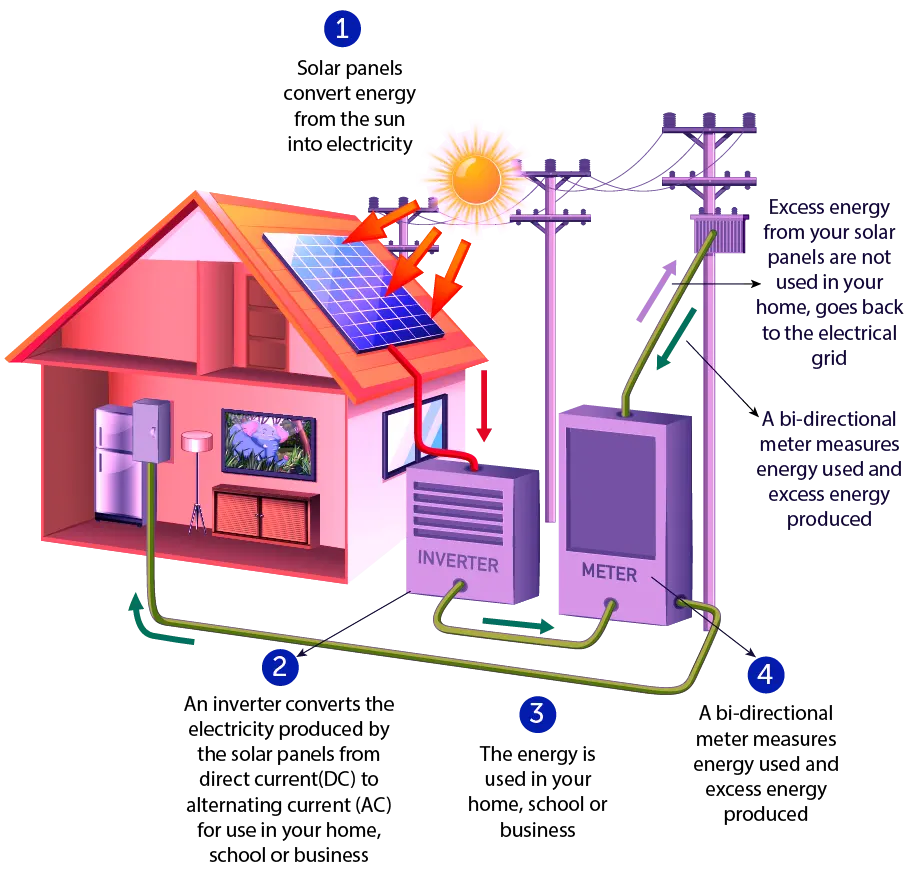Ongrid Solar For Homes: Full Guide About Benefits of Solar, Price of Solar Panels, Solar Subsidy In Kerala

What is Ongrid Solar?
Grid Connected Solar or Ongrid Solar is the Solar Power which is connected directly to the Grid, usually without Batteries. Ongrid Solar is live solar power connected to our loads and the utility grid without any backups. Whatever solar power generated during the daytime is live fed to the loads for immediate consumption, and if there is excess generation more than the live consumption, it will get exported to the external grid. Similarly, if your consumption is higher than the live solar generation, then the excess energy needed for consumption is imported from the external grid. All this happens in a smooth synchronized manner and no user intervention is needed for any of this. To know more about Ongrid Solar, we are always ready to help. Click here to call us! Or Click here if you want to contact us to know moreWhat loads/equipment can be connected to an ongrid solar power plant?
Since the solar power plant is connected to infinite loads, the loads of the house to which ongrid solar is connected is immaterial. If your consumption is higher than the live solar generation, then the excess energy needed for consumption is imported from the external grid. All this happens in a smooth synchronized manner and no user intervention in needed for any of this. Hence, high load equipment such as Air Conditioners, Electrical Motors, Pumps, Refrigerators, Electric Cars, Electric Scooters, Induction Cookers etc can be connected to ongrid solar without any issues. To know more about Ongrid Solar and loads supported by Ongrid Solar, we are always ready to help. Click here to call us! Or Click here if you want to contact us to know moreWhat are the various components of an Ongrid Solar System?
Solar photovoltaic modules (PV modules), inverters, module mounting structures (MMS), bi-directional metres, cables, safety devices, and tools for the balance of the system are among the several parts that make up a home solar plant. Solar technology is always evolving, making solar components incredibly adaptable, robust, and ideal for almost any sort of property and climate. To know more about Ongrid Solar Components, we are always ready to help. Click here to call us! Or Click here if you want to contact us to know moreWhat are the Benefits of a Home Solar System?
The future of residential energy is solar power! Solar is good for the environment as well as our wallets. The primary incentive for households to choose this green energy technology is energy savings.Money-saving - Solar can help you save a lot on your annual electricity expenditures and can pay for itself in as little as 4 to 6 years. Over time, you not only make back the initial investment you made in your home's solar power system, but you also continue to generate your own affordable domestic electricity (solar power plants could easily last for 25 years or more!), which boosts the return on your solar investment over the course of its useful life.
Increases the value of the house - Installing solar is a lovely enhancement for your house and a fantastic selling point if you ever decide to sell it. A solar-powered property can also affect a buyer's decision to buy a home because the buyer will prefer a house with a working solar power system built into it. More purchasers will be drawn to a home powered by solar energy since it will provide them with affordable electricity for years.
Grid independence - Installing a solar energy system at your home in India might provide you grid freedom. You have the option of creating your own household electricity using a home solar power system with battery storage technology, which will allow you to either totally cut yourself off from the grid or lessen your need on it. With Ongrid Solar, you decide how much power to produce!!!
Inexpensive - Owning and caring for a solar power system at your house is simple. Modern solar systems have a lifespan of over 30 years and are extremely robust and weather-resistant. Your solar panels will produce electricity for all of your residential needs for years with little maintenance and regular cleaning.
Environment-friendly : The conventional method of producing power using coal as a fuel results in air pollution and the release of tonnes of hazardous gases into the environment. The best method to reduce emissions and protect the environment is by utilising renewable energy sources, like solar.
There are more benefits of Ongrid Solar depending on different use case scenarios. To know more about the benefits of Ongrid Solar, we are always ready to help. Click here to call us! Or Click here if you want to contact us to know more
How a Home Solar System Operates?
Solar PV systems, to put it simply, are modern power generation facilities equipped with solar panels that take in sunlight, convert it to energy, and then use other parts to provide you with a useful supply to power your appliances.How a Home Solar System Operates The photoelectric effect is the underlying concept that drives solar systems. The main generators of electricity in a home solar setup are solar panels. A number of solar PV cells that effectively catch sunlight make up each solar panel. Semiconducting materials are used to construct each PV cell. The photoelectric effect occurs when light strikes this substance, moving electrons that then create an electric current to pass through the material. This electric current is captured by the wire connecting solar cells on your roof's solar arrays, which produces DC electricity. Since your usual household electronics and appliances can't run on DC current, the energy is first transformed into AC current by a solar inverter before being used in the home or fed into the grid.
To know more about how Ongrid Solar operates, we are always ready to help. Click here to call us! Or Click here if you want to contact us to know more
How to Pick the Ideal Solar System for Your Home
What kind of system will work best for you will depend on your motivations for contemplating a home solar power system. You can make an informed choice by comparing the costs of each type of solar system with your annual energy usage and the solar plant cost for your house. Let's say your largest source of pain is your monthly electricity bill, and you're thinking about going solar to lower your overall energy costs. A home solar system that is connected to the grid will thus enable you to lessen your reliance on the grid. You can also benefit from net metering at the same time (more on this in the FAQs).To know more about Ongrid Solar and how to chose the system that best suits you, we are always ready to help. Click here to call us! Or Click here if you want to contact us to know more
Installing a Home Solar System
You must follow a few essential guidelines while making the move to renewable energy sources if you want to get the most out of solar power systems for your home's electricity.Examine the energy efficiency of your house. You can find out how your home consumes electricity and whether you're wasting any precious resources by having a comprehensive energy audit performed on it by a reputable electrician. Additionally, check to see if any of the lighting and appliance systems you use are outdated, inefficient models, and think about replacing them.
Discover the solar potential of your house. Even while direct and dispersed sunlight can both be captured by modern solar equipment to produce energy, certain homes might not have enough solar potential to justify the cost. Verify whether your roof receives adequate sunlight throughout the day and look for adjacent trees and plants that could shade your solar panels. Older homes may have compromised roofs that require replacement right away or in a few years. Additionally, if your neighbourhood homeowners organisation oversees your property, be sure to ask them if installing a private solar system for your house will be appropriate.
To know more about Ongrid Solar, we are always ready to help. Click here to call us! Or Click here if you want to contact us to know more
Indian Homes Cost of Solar Plants
Do you know the price of the solar system? Here are some numbers showing how much various residential solar systems cost on the market. The size of your property and its energy consumption requirements will determine the best home solar power system and the components it will need to fit you and your family, with capacities ranging from 1kWp to up to 10kWp for domestic usage. The cost of solar plants for homes is directly impacted by solar brand, location, marketing, and availability. Also keep in mind that any state or federal government subsidies or other financial aid programmes are not included in the above pricing.To know more about How much Ongrid Solar Costs, we are always ready to help. Click here to call us! Or Click here if you want to contact us to know more
India's Home Solar Subsidy
Thanks to the encouragement and support Ministry of New & Renewable Energy (MNRE) has been giving to the renewable energy field in India in the last 2 decades under the leadership of various central governments, renewable energy and especially Solar Energy has become affordable and popular across the country. In the last 7 years, under the leadership of the Central Government and State Governments to the renewable energy sector in India, it is contributing steadily to the ambitious, but achievable target of 175 GW of Renewable energy in the country by 2022 and 500 GW of Renewable Energy by 2030. The financial subsidy given to customers provided through the Central Financial Assistance (CFA) of MNRE has especially contributed to the development and widespread adoption of rooftop solar across the nook and corner of the country, including villages and remote rural areas. All such consistent, continuous and incremental initiatives by MNRE is noteworthy and appreciable. The lengthy list of benefits of their renewable energy alternative is substantially expanded by solar subsidies.The solar system for home pricing in India after subsidies are something to take into consideration if you've been on the fence regarding solar because of the prohibitive initial investment. Let's say your solar vendor advises you to choose a grid-connected solar plant with a maximum capacity of 3 kWp for your energy requirements. The benchmark cost of the solar plant for your home will then be eligible for a 40% subsidy (also known as Central Financial Assistance). Up to 10 kWp and above units receive a 20% subsidy. According to each state's solar policy, the benchmark price and subsidy rate differ from one another. Therefore, it's crucial to get in touch with a reputable solar firm that can make sure you benefit from government-provided financial help and lower the overall cost of solar power for your home.
To know more about Ongrid Solar Subsidies available, we are always ready to help. Click here to call us! Or Click here if you want to contact us to know more
FAQS - YOUR FREQUENTLY ASKED QUESTIONS ON ONGRID SOLAR
How can I calculate how much solar energy I'll need?
In India, your home solar system should produce enough electricity to meet your average annual electricity needs. Typically, 1 kWp Solar Power Plant in India will generate around 3-4 kWhs of Electricity per day, thus totalling around 90-120 units of Electricity per month. To determine your electricity requirements, go over your bills for the last year or more for your average monthly units consumed and divide it by 90 or 120 to get a rough estimate of the capacity of solar panels needed for your home. You can even request advice or, even better, an estimate from us to provide you an estimate on what capacity is required. We are always ready to help!We can accurately help you estimate your solar energy needs. Click here to call us! Or Click here if you want to contact us to know more
What does net metering mean for a household solar system connected to the grid?
A net-metered solar plant for the home enables you to draw power from the grid when solar power generation is insufficient on any given day because solar panels only produce energy during the hours of sunlight. On days when there is an excess of solar production, unused units are instead sold to the grid for solar credits. When delivering you the total monthly bill, the net metre keeps track of the flow of energy in both directions.Netmetering is the best form of metering for solar users. To know more, Click here to call us now! Or Click here if you want to contact us to know more
What if my roof doesn’t get enough sun?
Some homes may not benefit from solar systems if their roofs don't receive enough sunlight because of significant obstacles like the neighbor's property casting shade or the roof's unfavourable orientation. A solar installer can more accurately assess the solar potential of your roof or may advise you to join a community solar farm, which provides the benefits of solar without requiring you to put panels on your roof.We offer free site survey and analysis of your roof for solar feasibility. Click here to call us now! Or Click here if you want to contact us to know more
How long does it take for a typical solar systems for homes in India to pay for themselves?
The typical payback period for solar-powered homes is 5–8 years. Your payback period, however, can be influenced by a number of variables, including the cost of grid electricity in your location, the price of your solar system, the mode of payment (whether you took out a loan or leased it), and the amount of electricity you require. Regardless of everything, solar energy is advantageous for the majority due to its 25 years of consistent, affordable, and considerable energy output.We can provide you a customized and personlized payback analysis for your solar investment. To know more, Click here to call us now! Or Click here if you want to contact us to know more
Will my solar panels survive for a long time?
Your home solar power system will be covered by a 25-year performance warranty from many solar firms. Throughout their 25-year lifespan, the panels will continue to produce 85% of their initial production volume even though their energy output efficiency may start to fall after the first few years. After that, the output will start to decline, but the panels will still provide some electricity.To know more about solar panels quality and durability, Click here to call us now! Or Click here if you want to contact us to know more
Are there warranties on the individual solar energy system parts?
Solar panel warranties typically last 25 years. Although brand-specific, the other parts, such as the inverter and batteries, are also covered by sizeable product warranties. A workmanship warranty on the solar installation work will be offered by your installer as well.Solar System Warranties offered are one of the highest for any consumer product. To know more, Click here to call us now! Or Click here if you want to contact us to know more
Is solar system maintenance expensive?
Your home's solar system needs to be cleaned and maintained on a regular basis to stay operational. However, because solar panels don't have any moving elements, significant failures in rooftop solar installations are improbable. Your regular maintenance requirements usually may also be covered by an AMC plan from your solar provider. Periodic inspections and other thorough services are included in this maintenance package, which helps to minimise downtime, increase system performance, and prolong the life of your home solar plant.To know about the risks and maintenance aspects of Solar Panels, based on our experience, we are always ready to share honest feedback. To know more, Click here to call us now! Or Click here if you want to contact us to know more
Polycrystalline Panels Vs Monocrystalline Panels
Polycrystalline are the most proven and time-tested technology in Solar Modules having more than 60 years of field-tested and proven trackrecord. Monocrystalline modules are relatively new technology, and they have higher area-efficiency in terms of output from a unit area of light falling on it, and conversion to electric energy. However, a 3 kWp power plant, whether using monocrystalline modules or polycrystalline modules will generate the same output under STC (Standard Test Conditions) conditions, just that the Monocrystalline modules will help you save some area (maybe a few square meters). Remember, a 3 kWp Solar Panel, whether Monocrystalline or Poly Crystalline have been tested for 3 kWp in the factory before shipping; and will generate the same power output and you are only paying for the Wp output of the solar panels, not for the technology! Thus, in all practical conditions, the only difference between Monocrystalline solar panels and polycrystalline solar panels are that monocrystalline modules can save some area (maybe a few square meters) needed to generate the same output; There is no change in output. Monocrystalline modules are more expensive compared to Polycrytalline modules. Thus, if you have a lot of area to work with or if roof area is not a major constraint, you might find it more cost-effective to install more polycrystalline panels on your property to suit your energy needs because their price point is lower while generating the same power output. Depending on where you live and how much area you have, polycrystalline panels can be a better value for money and investment for you, and technology is also advancing quickly in this area.Confused between Polycrystalline and Monocrystalline modules??? Click here to call us now! Or Click here if you want to contact us to know more












